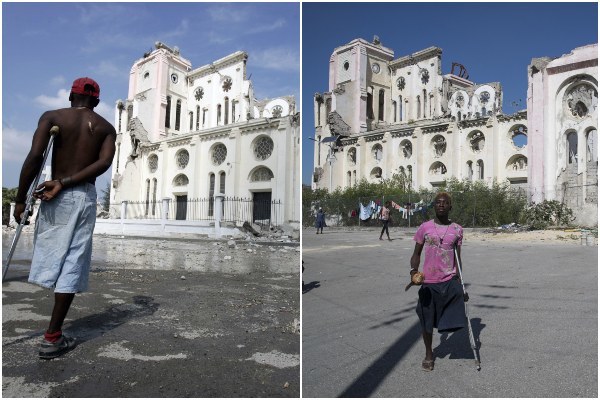DANIEL LOZANO
Sunday, January 12, 2020 - 02:48
- Share on Facebook
- Share on Twitter
- Send by email
In the nightmare of the Haitians the same sound is repeated again and again, heartbreaking, relentless: "Goudou, goudou!". A decade ago the earth bellowed for 35 seconds with such force that it swallowed part of its capital, Port-au-Prince. As if it were an atomic bomb of nature thrown cruelly and viciously against the poorest country on the continent.
The 7.3-degree earthquake on the Richter scale, the gigantic "guodou goudou" that blew up much of the country, turned Haiti on January 12, 2010 into an end-of-world laboratory. Two immediate aftershocks, a score in the early hours and countless during the first days deepened the devastation.
The greatest natural tragedy of the century: more than 300,000 dead, almost 400,000 injured and thousands of disabled. More than 100,000 homes completely destroyed, another 200,000 with very serious damage, hundreds of schools and health centers unused and 1.5 million people forced to live in 1,150 refugee camps. For years walking Port-au-Prince was like entering the worst zero zone of the planet.
Haiti did not expect an earthquake, although its capacity to prevent it was minimal. Their houses, built with heavy roofs to combat hurricanes in the Caribbean, collapsed as if they were an accordion. From the Presidential Palace to the cathedral through the Parliament and most public buildings. René Preval, president then, escaped the miracle of the collapse and got on a motorcycle that was passing by. Days later he wore the same clothes, to make it clear that the earthquake had also pulverized the fragile Haitian state.
At least the monument to the liberator of a brave country, Toussaint Louverture, remained in the heart of the Mars Field, which for years became the largest refugee camp on the continent. Haiti was the first country to conquer its independence in Latin America, a land of slaves upon which they spear their spears with the heads of the slaveholders to start a new era against the tide. Always against the current.
The figures of the Haitian Apocalypse are of such magnitude that they would occupy all this chronicle. "Everything changed forever," the young brunette predicted a reporter a decade ago. And she succeeded. Ten years later, Haiti suffers the attacks of different biblical plagues. First was the cholera epidemic, which took 10,000 more lives. Then came two hurricanes, which consolidated the extreme poverty of its population. Corruption and political mismanagement preceded the protests, which have kept the Caribbean country in constant fray for months.
Another example loaded with symbolism is enough to measure Haiti today: the current president, Jovenel Moïse, dispatches in the guard depots of that time because the majestic national palace was not rebuilt despite the money invested by France. Few know if those 75 million arrived at some point and, if so, where they went. For now, today it will be announced publicly who is the winner of the contest for the reconstruction of the palace. A decade later ...
In just 35 seconds, more than 7,000 million dollars were lost, a figure that exceeded the GDP of the previous year. But the flow of funds from abroad were never well used. Exemplary, despite everything, was the solidarity of the Spanish people, who were already suffering the vicissitudes of the economic crisis: third donor in public aid during the first year and one of the main donors in private donations.
So much effort had little impact on the disinherited, the main victims of a reconstruction that seems eternal. 35% of Haitians remain in humanitarian emergency, 54% in extreme poverty. Sanitary infrastructure on the edge of the abyss, according to Doctors Without Borders, whose work was essential after the earthquake. Port-au-Prince is one of the most violent cities on the planet. The basic infrastructures only provide services to a part of the population.
"It is unacceptable that some people wallow in an arrogant and scandalous opulence while the majority of the population languishes in shameful and rebellious misery," denounced the Episcopal Conference earlier this year, summarizing the popular clamor.
Against wind and tide and on such a panorama, Moïse does not give in and stays ahead. "My fight is to return this country to the people of Haiti. I guarantee that I will endure until the Haitian people achieve victory," he cried after receiving the support of Luis Almagro, Secretary General of the OAS, and continuing what he says is his crusade. Against corruption
In his must is the brutal repression of the police against the protesters, made up of several opposition groups, from those who fight against manifest misery to those who do not want to lose the privileges of the old politics. Moïse has the support of Canada and, above all, the US, which sent elite troops to protect him, also worried about the instability that was growing in the neighboring Dominican Republic.
The heir of Michel Martelly, the carnival singer who led the reconstruction of the Caribbean country and who is the main favorite to succeed him, has been splashed by the corruption unleashed around PetroCaribe's funds, already initiated with Preval. From tomorrow, he will govern by decree, when the elections to renew the two parliamentary chambers have been suspended for months and the period of deputies and a good part of the senators will end.
According to the criteria of The Trust Project
Know more- Earthquakes
- international
- America
America An earthquake in Puerto Rico destroys one of its tourist icons
Asia At least four killed by a 6.8-degree earthquake in southern Philippines
Latin America At least 12 prisoners killed and 13 wounded in a shooting in a prison in Panama

